1977 Chevrolet Vega Estate: Needle in a haystack in Monmouth!

Another Vega? As Marge Gunderson said in Fargo: Oh, yeah! One would think in this day and age that finding a Vega, the notorious GM subcompact that polarized so many, would be a difficult task. But some way, somehow, I keep finding them. Or word’s gotten out and they’re finding me!
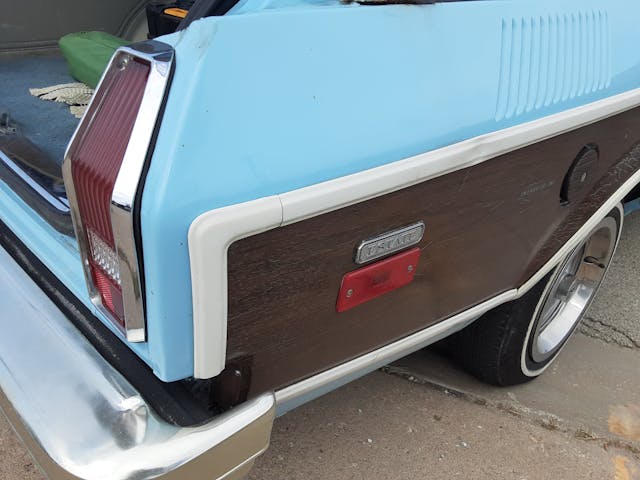
I’ve mentioned it before, but the Maple City Cruise Night, held annually in the small college town of Monmouth, Illinois, is a must-attend event for me. Essentially, the whole town turns into a car show. And anything goes! It’s a show where you really never know what you’ll see. I love that.

Last year there was a mint condition 1977 AMC Gremlin X. In previous years I’ve seen a 1976 Continental Mark IV with the Lipstick Luxury Group, a 1959 Dodge Royal Lancer, spectacular 1964 Cadillac Series 62 in Turino Turquoise, a 1976–77 Mustang II Ghia, a remarkably well-preserved sky-blue 1973 Pinto Squire, and a giant red 1974 Cadillac Eldorado convertible that would have done Big Enos Burdette (of Smokey and the Bandit fame) proud.

It isn’t like the local monthly or weekly cruise nights, where you start seeing the same cars over and over. Here, there is always something new. Some cars I’ve seen once and never again. You’ll see license plates from Iowa and Illinois and Missouri, sometimes even Wisconsin. It’s grand.
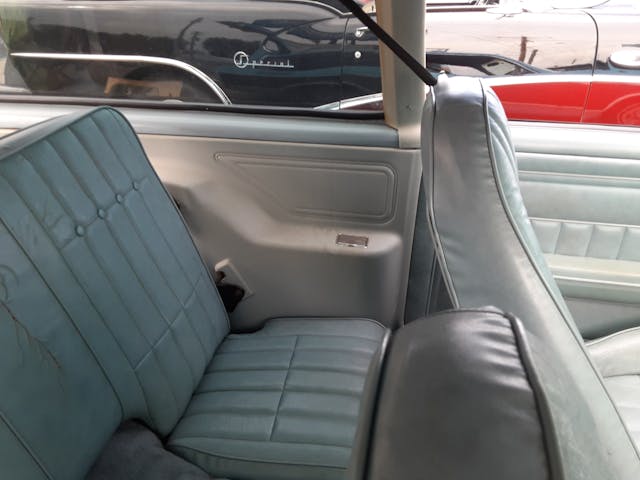
And so it was in August, when I hopped in the car and pointed it onto I-74 and then Highway 34 to Monmouth. As always, I made sure I had plenty of memory space in my camera and a fully charged battery. Once, at a Cadillac and LaSalle club show in Milwaukee, my camera flatlined just as I was taking pictures of a fantastic 1968 Fleetwood Series Seventy-Five limousine. I vowed then and there that I would never have that happen again.
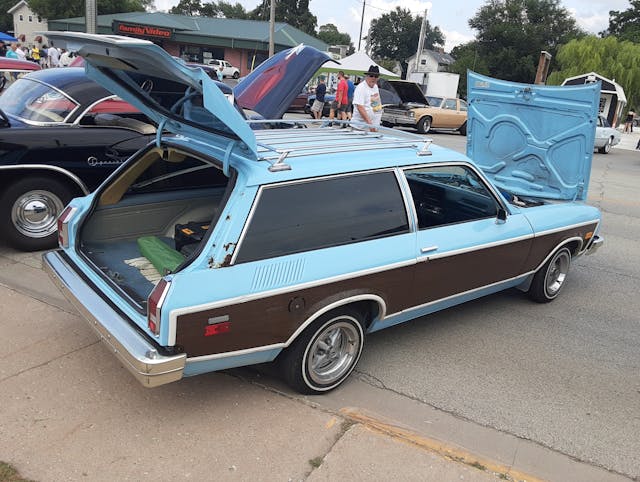
But I am digressing again! Back to our featured car. When I initially posted a few pictures of this car on my Facebook page, my friend Jim Smith, who worked as a lot jockey at a big Chicago Chevy dealer back in the ’70s, had this to say: “Rare as a purple unicorn. I only recall having one, in white, in demo service at the dealership.”
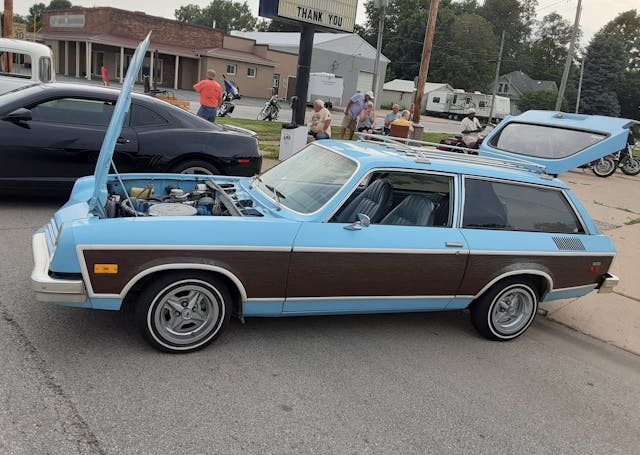
He wasn’t wrong. When I was researching in my home automotive library to write this column, I found that only 3461 Vega Estates were built for 1977, which was the last year for a Vega in any form. The non-woody version was much more plentiful, to the tune of 25,181 units.
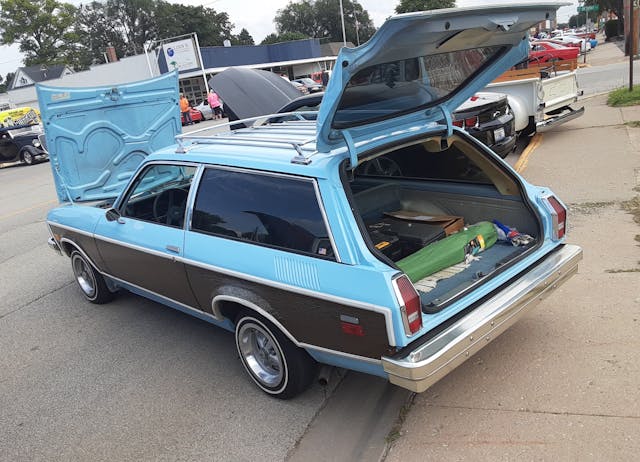
The ’77 Vega Estate had a base price of $3745 (about $18,975 today). As the 1977 Chevy station wagon brochure confided: “Vega. It might just be all the wagon you need.” And there was definitely a somewhat defensive tone in the description as well. Anyone around in the ’70s will remember the Vega had some teething issues upon its debut, the severity of which depends on who you ask, but regardless, rust, breakdowns and other functional complications were evident.

As the brochure continued, “Yes, it’s still the compact wagon that’s just right for today’s young thinker, regardless of age. And Vega’s still the wagon that offers an engine built to take it.
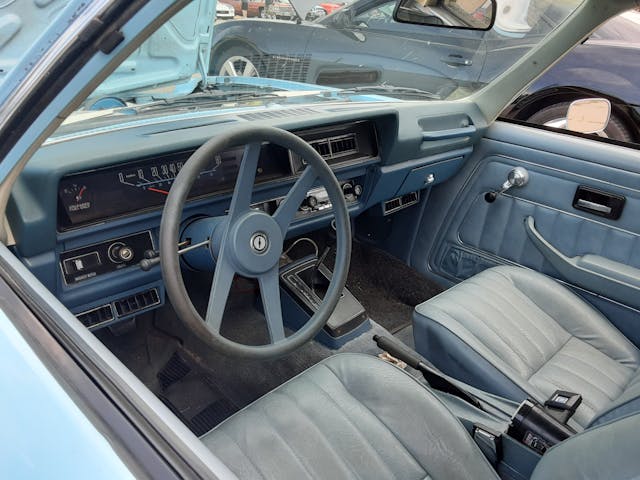
“We documented that when three 1976 Vegas, with Dura-Built 2-barrel carburetor engines, conquered 60,000 miles in and around Death Valley in 60 days in the summer of ’75. Maintenance was adjusted for dust conditions. Only one timing belt was replaced and 24 ounces of coolant were added to one of the three engines.”
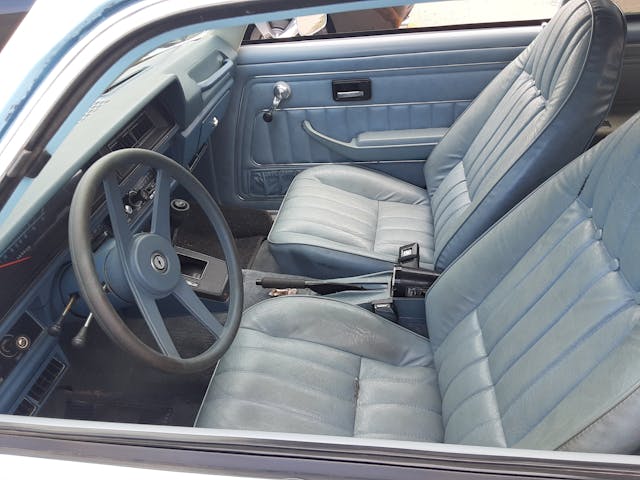
I can’t speak for every Vega owner out there, of course. But my aunt Lori Klockau had a mid-’70s Vega Estate as a student teacher at the University of Iowa back then. Believe it or not, it was a Vega Estate, too. At any rate, she drove it for several years, and that little woody wagon ran like a Swiss watch. She never had any trouble with it. Of course, others’ mileage may vary. But even today Aunt Lori remembers that car fondly.
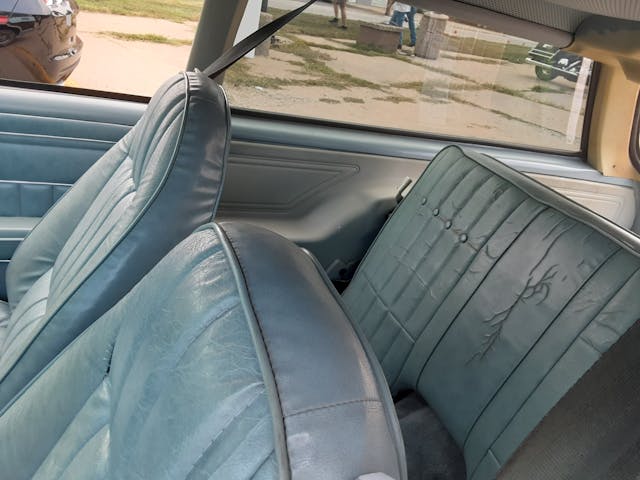
As for the 1977 Vega Estate, naturally it was a bit flossier than the plain-Jane Vega wagon. The biggest attraction, of course, was the “New simulated oak wood-grain paneling with simulated wood-grain outline moldings on the rear and full side panels.” The “new” must have been referencing the type of wood-grained paneling used, since there had been woody Vega wagons since 1973.
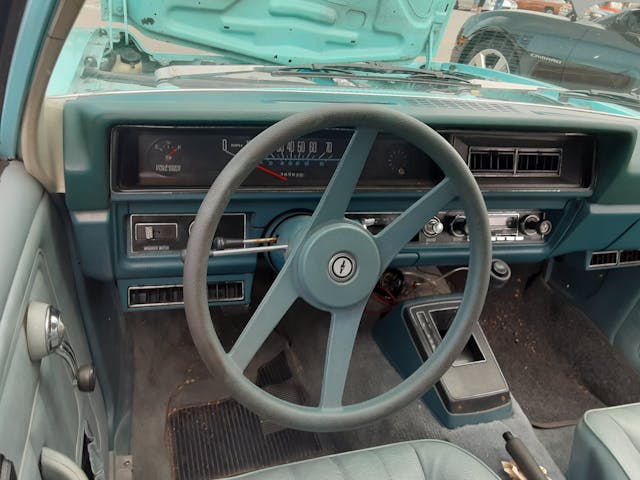
Other extras on the Estate included full wheel covers, deluxe bucket seats and trim, custom door panel and rear side panel interior trim, a day/night inside rear view mirror, the all-important (in the 1970s) rear seat ash trays, and more. A Vega GT wagon was also available, though there were no separate production breakouts I could find.
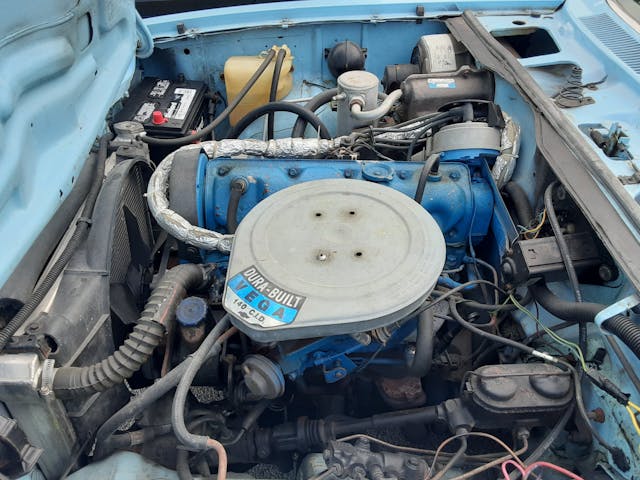
Our featured Vega Estate was finished in code A-2929 Light Blue with a complementary light blue vinyl interior, and optional Rally II wheels. It also appeared to have factory Four-Season air conditioning, judging from the vents along the bottom of the instrument panel.
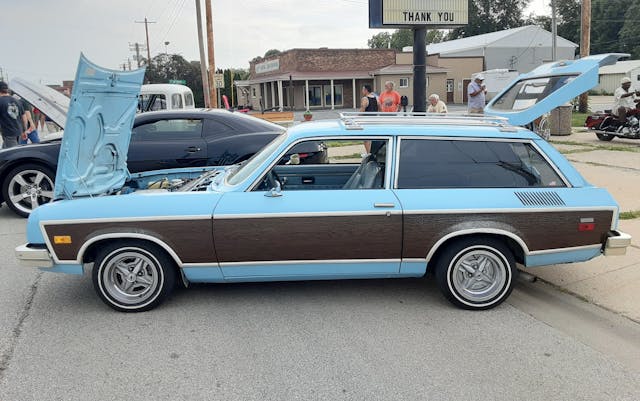
I had just gotten over gawking at a 1976 Lincoln Continental Town Coupé at the show when I saw this Vega woody and briefly lost my mind. Holy cow, what a rare birdie! I have seen a few Vegas, but frequently they are hot rodded with a small-block Chevy V-8 and fat rear tires. But here was a bone-stock Vega—and an Estate!
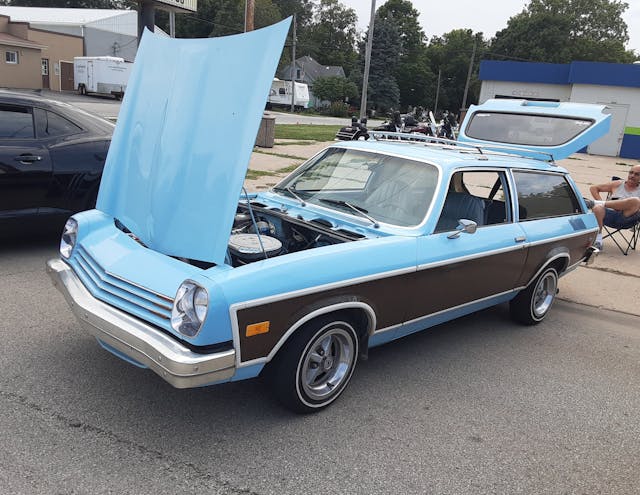
I’m not 100 percent certain, I may have seen one or two long ago when I was a kid in the ’80s, but this was definitely the first Estate I’d seen in 25 years, at least. Yumpin’ yiminy!
After I regained consciousness and a nice lady helped me stand up, I began taking many, many photos of it. I loved it. I spoke with the owner, a very nice guy, and he confirmed it was a 1977. I knew it was either a 1976 or ’77, due to the grille. What a time capsule—not mint, but a very honest original car. It was a treat to see!
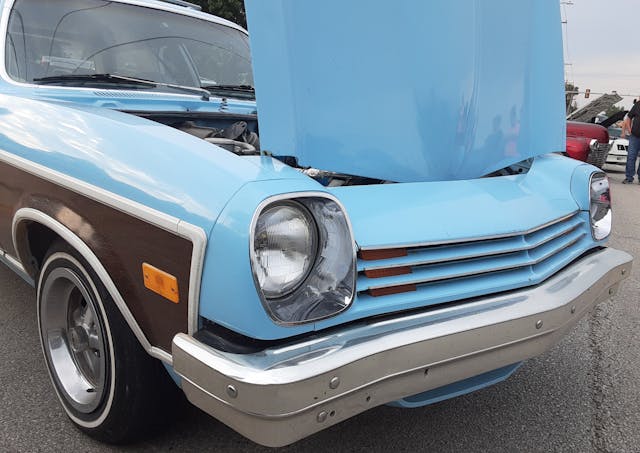
***
Check out the Hagerty Media homepage so you don’t miss a single story, or better yet, bookmark it. To get our best stories delivered right to your inbox, subscribe to our newsletters.


Some one checked a lot option boxes. A/C, tilt wheel, radio, automatic transmission, rally wheels, exc. I imagine when the A/C was turned on the car lost a lot of speed. It is amazing that theses are still out there. Nice find Tom and a Merry Christmas to Tom and the Klockau Classics world wide audience….and don’t get run over by a reindeer this weekend…
I bought and drove a 76 Vega Estate wagon in yellow with AT and comfy cloth interior for 120000 miles. Slow as heck! Changed the timing belt every 20000 miles after it broke at 18000 miles first time. Good for hauling small family and groceries. Prone to a lille rust. Repeated allingments. Cute car until yellow became unfavorable color. Served us well for 10 years.
I bought a first production year Vega wagon. It was my first and last American car. The reason why Vegas are rarely seen is because they have disintegrated into a pile of rust. I had several rust-throughs in the first two years. Chevy gave me new fenders, but I could have used a new body. My gas mileage started poorly at around 20 MPG and dropped to around 10. The dealer wouldn’t touch the carburetor so I opened it up and found the power valve had unscrewed itself. My mileage improved to around 25 to 30 MPG. What else? The alternator failed on my first road trip. The clutch pedal was getting extremely hard to depress; the clutch cable was sawing its way through a seized nylon pulley. Oil consumption started out at less than 1000 miles per quart and dropped to around 700. Chevy said when it got to 500 miles per quart they might give me a short block. Two other folks where I worked had similar issues. The Vega was a genuine piece of crap!
…huh?
This was GM’s Fiat. Instant rust and engine problems, and sagging front crossmember. Few in the lake effect snow belt made it to the end of the payment book.
Really? I havent seen a rusty 76-77 Vega yet. You dont know what youre talking about. They had galvanized fenders and rocker panels.
RARE VEGA OPTIONS _ 1977
Z29 GT Equipment Package ’77—4,276
M75 5-Speed Borg-Warner T-50 Manual Transmission ’77—2,377
19A Sports Striping ’77—862
32L / 32U Light Lime ’77—1,463
Duke Woolworth
GM’s Fiat hugh?
1976-77 extensive anti-corrosion measures
Front fenders and lower radiator support are zinc plated steel
Zinc plated steel corrodes at about 1/30th the rate of raw or untreated steel and is naturally resistant to oxidation-related damage like rust and corrosion
Rocker panels are galvanized steel
Galvanized steel involves the hot-dip method whereas zinc plated steel involves the use of an electrical current,. Both zinc plated steel and galvanized steel have a protective layer of zinc. The outer layer of zinc shields the raw steel from moisture so that it doesn’t rust or corrode.
In addition to the normal seals, drains and paint operations, the doors receive a zinc-rich pre-prime coating on inner surfaces. Edges of the doors are sealed with plastisol to keep out water. After painting, the inner doors receive an aluminum wax spray to help protect the finish against corrosion.
A non-rusting plastisol seal has been added to the hood edges
Corrosion resistant plastic clips are now used to install window moldings
A zinc-rich pre-primer is applied to the inner body surfaces immediately in front of the windshield.
Drain holes have been added to the windshield wiper depressions.
There is an anti-corrosion wax spray on top of the primer and body paint around the windshield’s flanged edges.
An expandable sealer has been installed between the quarter panel and the wheel housing panel.
Upper and lower grill panels and headlight surroundings are now made of corrosion resistant material
–
plus five coating fender protection used previously
Elpo rust protector
A sealing primer is applied to the entire inner fender
Three sealing coats of protective acrylic lacquer
The plastic inner fender skirt is bolted to the car which forms a full seal with the side panel
The entire wheel well area is sprayed with protective mastic that also helps to cut down road noise
Hemmings Classic Car editor Craig Fitzgerald said in the August 2006 issue
The idea that the 1971 to 1977 Chevrolet Vega was an unpopular lemon from day one is a myth.
About 95 percent of the 3,900 welds on the car’s body were completed by robots, something commonplace today, but in the early 1970s, it was wildly futuristic.
Road & Track called the Vega “the best handling car ever sold in America,” “one of the finest-looking compact sedans in the world,” and went on to compare its styling (coupe) to the Ferrari 365 GT 2+2.
I would say that the folks who always claim the Vega was rubbish were the types that neglect or abuse cars. My ’71 Vega had 200K miles on it by 1982 and has 400K on it now. Yes GM did replace the engine for free at 60K miles in 1973 but that second engine ran for 157K when I rebuilt it in 1984. That 3rd engine is still in the car and going strong today with only a valve job in the late ’90s. I also have a ’74 Vega with 131K miles on it’s current 30 year old engine. Keep the oil in good shape and NEVER let them run hot and they are very durable and reliable. My experience in Texas is that Vegas do not rust any worse than most other ’70’s cars. I always attack rust as soon as it appears so I never have had any severe rust issues. All I have ever driven on a daily basis are Vegas and I still think they are great cars for running around town with their good handling, brakes and ease of maintenance. I love not ever being held hostage to auto repair shops.
Vegas seem to generate a wide divergence of opinion. I’ve had several, and several Vega derivatives (Skyhawk, Monza).
They have several strong points.
Style, in all body styles, handling, especially in the GT package, interior quality.
But they also had a lot of shortcomings. Engines, especially had lots of failures. That was aggravated by the very small radiators the early cars had. Rust was a severe problem, until the use of galvanized steel. I’ve had Vegas with rust holes in the roof, around the windshield, and everywhere else you could imagine.
On the balance, they were terrible cars for people that expected trustworthy transportation.
The only shortcomings concerning the Vega are the lack of knowledge of most people concerning the car. There weren’t any shortcomings consee ining the car itself as far as its design. if you choose to start a debate with me you will surely lose.
Prove it. You have no idea what you’re talking about. You’re claims are baseless and not factual. Just another critic that doesnt know the facts. In the real world it was a reliable car. All new car and engine designs have teething problems the first year including cars on the other end of the Vega’s price class. The Vega was no different than any other all new vehicle foreign or domestic. Road and Track magazine reported in a Vega owner survey 16 % of owners reported no problems at all which was a higher percentage than any other car in 1972. I will provide the facts. You won’t ve able to. Al l you have is a useless opinion. Nobode cares about opinions, only facts.
Why so angry over a car? I had an orange with white stripe over the top “Millionth Vega”. Tan interior with an auto trans. Reliable car for quite some time. Put new shocks on it with some aftermarket white solid steel wheels and new radial tires. Only sold it because wife wanted a car with A/C. No regrets and kinda wish I still had kept it. Very easy to work on and reliable as long as you followed the”Take care of it and it will take car of you” mantra.
The key with any Vega is to make sure the cooling system is up to snuff. When GM replaced the engine in my ’71 the expansion tank was added and radiator was upgraded to the HD style. After that it became extremely durable and reliable. When I added AC I had the radiator shop add a 3rd core to handle Texas heat along with a gauge package to keep a close eye on temperature and oil pressure. On my ’74 with AC, header and 10:1 pistons etc I run a 4 core and also electric fan in front of the condenser so the AC is nice and cold. It has been my summer car since 1997 with zero engine or AC problems. Gentle warm up periods help too for longevity.
The very last 77 Vega down the line was identical to this car.
Or at least the one rumored to have been found in the early 2000s.
I like the color but getting excited about a Vega is a hard thing for me to do.
I had a new Vega GT. Piece of crap. Worst car I ever owned. Sold it as soon as I could find a buyer.
My sister and brother-in-law bought their first ever new car – a silver Vega GT with black stripes. Galvanized fenders? The first rust showed on the tops of both fenders. It was sharp and a fun 4 speed, but…. And, I am a Bowtie guy!
Wow, this brought back a lot of memories. In 1979-81 I had this exact car and color combo but in a 1974 model year with hubcaps. A few friends made fun of me but I remember putting the back seat down and utilizing the back cabin in ways we can talk about here…
Google Chevy Vega and here is what comes up! People also ask,
Why did Chevy stop making the Vega?
The Vega was a failure for Chevy because of engine issues with the aluminum die-cast engines. The valve stems were found to be faulty within the engines, allowing oil to seep through into the combustion chamber. This caused repairs that the company deemed unrepairable because of the aluminum aspects of the engine. Nov 14, 2022